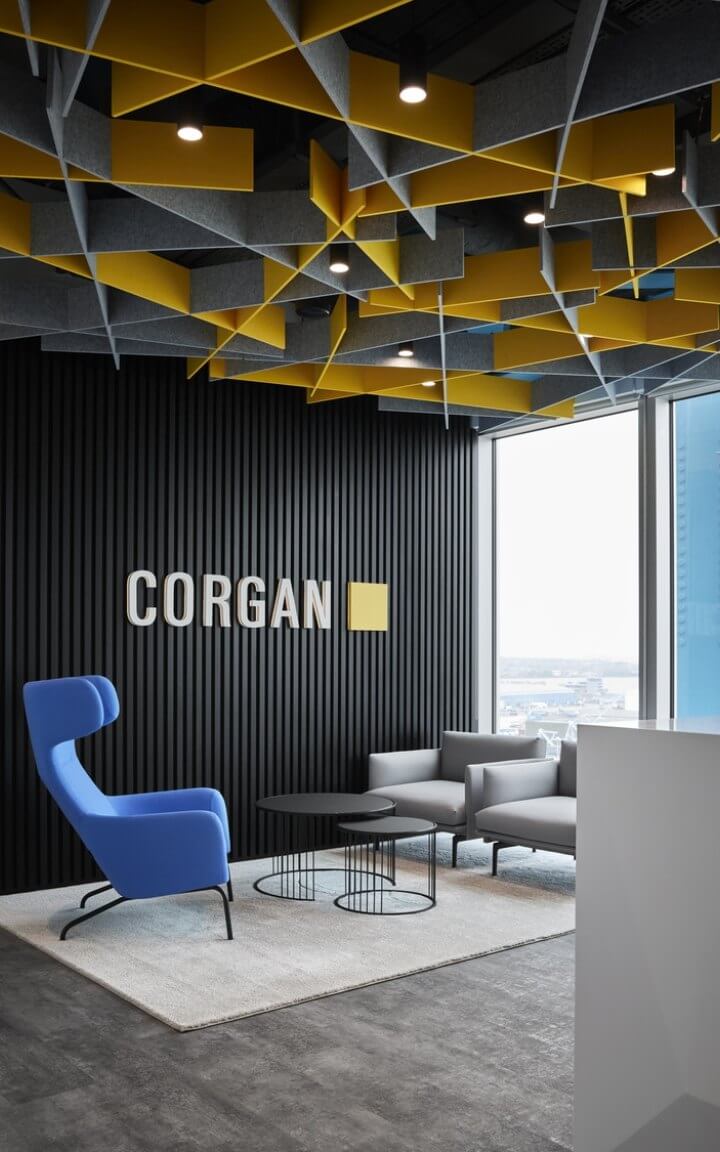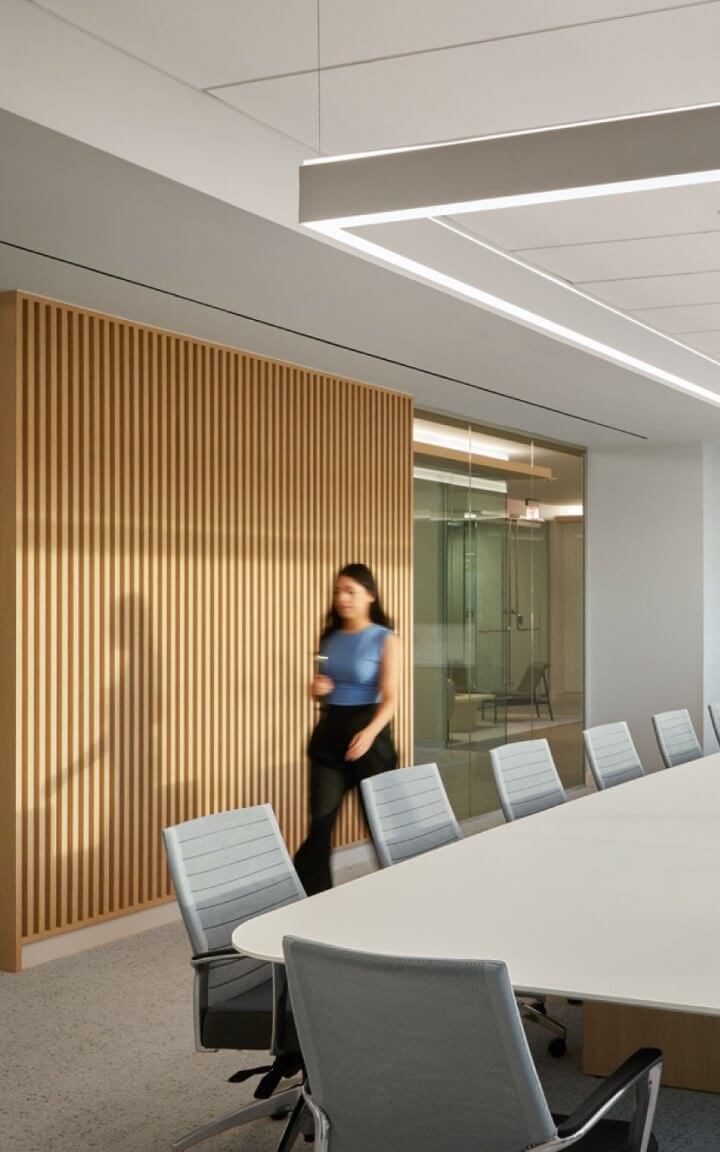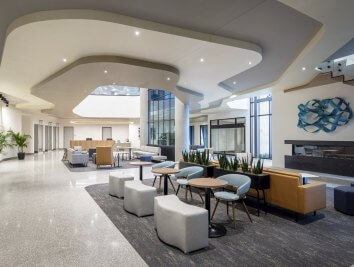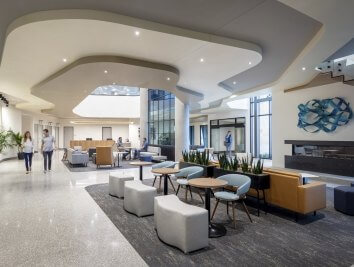Designing for Mental Health: Healthcare

Designing to support mental health is especially significant for the healthcare industry. As the patient care journey shifted during and after the Covid-19 pandemic, supporting mental health, fostering trust, and mitigating stress became especially important.
The mind-body connection
Covid-19 changed a lot of industries, but maybe none so much as the healthcare industry. An industry in which the most important element is the care of people, the shift in healthcare and its design is more than an uptick in virtual appointments. The pandemic and its fallout refocused design and care to consider the ways we behave, prepare for small and big changes, and create a physical space that enhances and integrates with the journey of both patients and the provider. The pandemic also put renewed emphasis on mental health—a critical part of our wellbeing that is often left out of the puzzle in favor of physical illnesses.
Healthcare facilities can be a stressful place to begin with, both for patients, who likely have concerns or fears about their health as well as for providers, who make many high-stakes decisions day in and day out. There is a strong connection between mental health and physical health. Research shows higher rates of mental disorders (like depression) in people with poor physical health, especially in those with chronic conditions. Likewise, research shows that people with mental health problems are at a higher risk of developing physical health problems. So, designing to support mental health in a healthcare setting can further advance the facility’s mission.
Calm, connected, and in control
An ideal patient journey is all about connecting the patient to the provider in a way that feels seamless and satisfies the patient’s concerns. These days, visits happen both in person and virtually, so both experiences should be considered: how can designers help patients feel safe, heard, and connected to their provider? For telehealth, private offices where providers are able to take calls in a professional, environment is helpful in showing legitimacy and building trust. For in-person visits, exam rooms are becoming more conversational to facilitate a collaborative care environment.
Another way that healthcare design can support a patient’s mental health is by empowering them to make their own decisions during and about their care. By giving the patient the reins, we can restore control—which positively impacts mental health—in a situation that might otherwise feel entirely out of their control.

Village Health Partners’ innovative self-rooming concept places more control in the patient’s hands.
At the Village Health Partners clinic in in Frisco, Texas, Corgan eliminated waiting rooms and instead used a self-rooming model that streamlines the patient journey and allows automony. Patients are also able to use the rooming app to manage additional information (like lab/test results and prescriptions) and schedule follow up appointments, further increasing the individual control and satisfaction.
Don’t stress me out
A key way to support both mental and physical health is to reduce stress: there are links between stress and mental health problems and high stress hormones can slow down the physical healing process. A lot of the elements that designers may use to convey comfort and reduce stress in other typologies—cozy materials, low light, plush fabrics—are not appropriate for a healthcare space where sterile, well-lit surfaces are key. However, there are ways to reduce stressors in healthcare facilities:

Clear Wayfinding
Clear wayfinding reduces the anxiety that navigating a large, labyrinthine building you may never have been to before may induce. Using color and physical landmarks can also help for patients who may not see well enough to read or speak a different language.
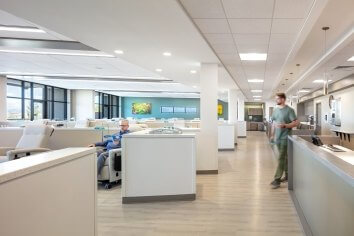
Natural Light
Natural daylight is known to be good for mental health, but can be hard to incorporate in a medical environment. Research shows that a patient-centered artificial light environment can have similar benefits on the circadian rhythm in a healthcare setting.
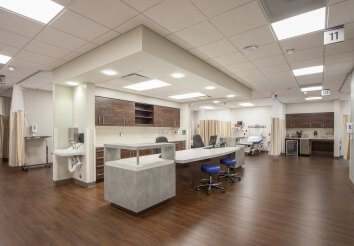
Cleanliness
Cleanliness is king in a healthcare setting, but even the perception of a room being dirty can be stressful. Distressed or patterned materials can look dirty and worn when they aren’t, causing patients to lose trust in their care.
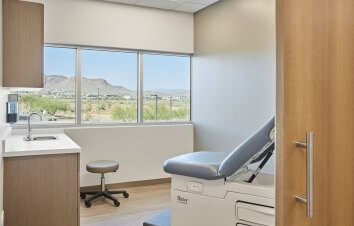
Biophilia
Views to the outdoors and natural materials (like wood and stone) are biophilic elements designers can incorporate to connect patients with nature – a strategy that has been shown to reduce stress have mental health benefits.
Over the years, materials available for healthcare settings have become much less institutional in appearance without sacrificing cleanliness. These materials combined with access to natural light, views or biophilia, clear and flexible wayfinding are changing the way we perceive healthcare environments.
Taking care of the caregivers
The pandemic was a uniquely stressful time for healthcare workers. Even as we ease back into normalcy, the pressure on healthcare workers to provide exceptional care within a changing framework remains. Healthcare design has primarily focused on patient health and wellbeing, but to support the mental health of those employees, we have to remember that the hospital is their workplace. Design solutions that work in standard offices — like personalization options including sit-to-stand desks or centralized nursing stations to incorporating mindfulness moments and biophilic design in break rooms — can help care for those responsible for delivering care. Applying best practices and design solutions from corporate counterparts, healthcare spaces can approach design as a workplace for nurses, doctors, and other healthcare staff — tapping into the power of the environment to boost engagement, productivity, and quality of care delivery.

We can also look to aviation design as a typology that offers lessons in designing for workers: much like airport employees, healthcare employees work in a place where the main user is just visiting or passing through. Designs for both places are typically focused on the passenger or patient journey, rather than the employee’s day-to-day tasks and stressors. To provide a reprieve from the stress of their public-facing jobs, designers should keep areas for employees to work privately or decompress separate from the care-giving side. Providing off-stage areas and circulation flows for caregivers allows for opportunities of collaboration, support, encouragement or simply a place to take a breath in private.
